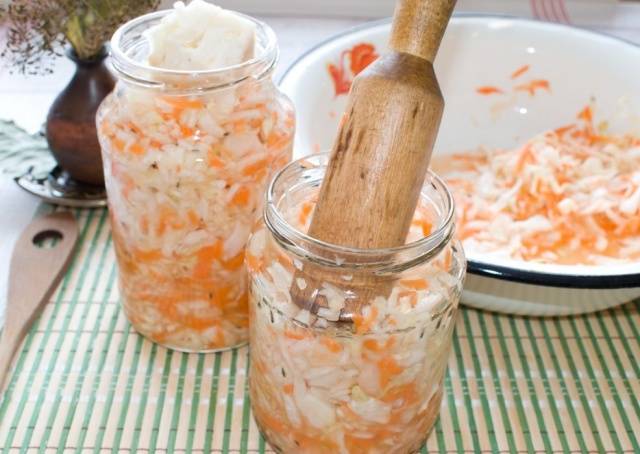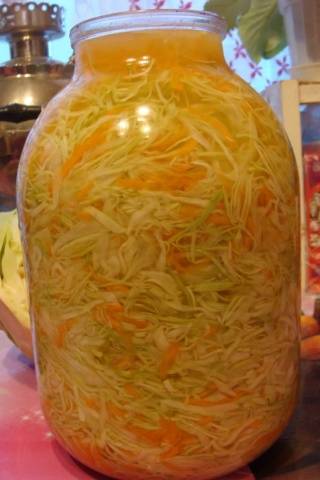Content
Russian people have long talked about cabbage as their second bread. It was consumed all year round, both fresh and fermented. She saved us in the most difficult times and was the best help in our diet. We even ate cabbage brine; it contains even more vitamins.
We will try to tell you how to cook sauerkraut recipe classic. This white cabbage vegetable was fermented in Rus' in large oak tubs, in which the preparation could be stored all year, and remained crispy and tasty. Although today many people make preserves in a jar. You can quickly ferment the vegetable either in its own juice or with brine. Classic cabbage is prepared with the addition of carrots and salt. Sometimes it is flavored with dill. But our recipe will be designed for a three-liter jar.
Benefits of fermentation
Today, few people use barrels when fermenting; most often they make do with enamelware or use jars. The method of fermenting vegetables in a jar has a number of advantages:
- fermentation occurs naturally, quickly, without any additives;
- thanks to the acid released during fermentation and being the best preservative, all useful substances are preserved in preparations for the winter;
- No pathogenic bacteria can survive in sauerkraut. Brine is the best preservative;
- when fermenting in the traditional way, a minimum amount of salt is used;
- classic recipes for pickling white cabbage do not involve the use of vinegar.
Preparing pickled vegetables in three liter jars does not take much time, although it does require skill. Then cabbage according to the classic recipe turns out quickly, is crunchy and tasty.
These secrets will come in handy
Quick sauerkraut is a classic of the genre. As a rule, it does not use granulated sugar or any ingredients other than carrots and salt.
- To get high-quality stock, use mid- and late-ripening varieties.
- Choose forks that are tight, with a dried crown. When cut, quality cabbage suitable for harvesting will be creamy white.
- The color of sauerkraut will depend on the method of cutting carrots: finely grated root vegetables give more juice and color the brine better.
- For fermentation, use enamel dishes or glass jars.
- Do fermentation on Monday, Tuesday, Thursday (men's days), when the moon is full.
- Salt vegetables only with rock salt. If you don’t have it, take fine table salt without additives, intended for preservation.
Classic is always in trend
The recipes we offer are classic, and will be presented with step-by-step recommendations for fermentation.There are many recipes, but we will take only two: a quick way to make sauerkraut in its own juice and brine.
Cabbage in its own juice
We will tell you how to ferment instant white cabbage in glass jars. For a 3-liter jar using the classic recipe we will need:
- white forks – 3 kg;
- carrots – 500 grams;
- salt – 2.5 level tablespoons.
Features of fermentation
We thoroughly wash the jars with hot water and soda, rinse and steam over boiling water. If you are not satisfied with three-liter jars, you can take three liter jars. Sauerkraut happens quickly and consists of step-by-step actions:
- We clean the cabbage forks from the covering leaves, since it is on them that sand and insects remain. Cut into pieces, remove the stalk. You can shred it in any way: with a knife or a shredder. The main thing is that the classic recipe involves fine cutting, since sauerkraut in a fast way.
- We wash the carrots from the soil, peel them and wash them again. Grate the carrots into the cabbage pickled in its own juice on a large-mesh grater.
- Place the prepared ingredients in a large bowl, add salt and knead well with your hands until the juice begins to stand out.
- Place a cabbage leaf at the bottom of a 3-liter jar. Then fill it with cabbage. It is inconvenient to compact it with your hands, so we use a rolling pin.
For any recipe, do not fill the container to the top so that there is space for the brine. - We insert a nylon lid inside, and on it a small plastic bottle with water as a pressure and cover it with a cloth to prevent dust from getting in. We put the jar in a tray to avoid damage to the table.
- During fermentation, which can last from 3 to 7 days, we pierce classic cabbage to the very bottom to release accumulated gases. If you don't pierce the cabbage, it will eventually accumulate bitterness.
- A cap of foam will also form on the jar, which must be removed. Cover the finished cabbage with a nylon lid and store in the refrigerator.
We have given you step-by-step recommendations for making quick sauerkraut. You can always improve the classic fermentation recipe, adding cranberries, lingonberries, apples or other ingredients.
Cabbage in brine
Cabbage pickled in brine quick cooking according to the classic recipe, its step-by-step actions are not much different from the previous description.
Recipe
Getting sauerkraut covered in brine is much easier. It turns out not only a quick preparation in a jar, but also a significant saving in time for obtaining the finished product.
We will have to prepare:
- cabbage – 3 kg;
- carrots – about 500 grams;
- salt – 4 tablespoons;
- granulated sugar – 2 tablespoons;
- clean water - 2 liter jars.
How to act
If you decide to use this step-by-step recipe, then we perform the work in this order:
- We clean the cabbage heads and chop them into strips.
- Three peeled and washed carrots on a coarse grater. You can use a Korean carrot shredder.
- Combine both ingredients and mix gently. According to recipes for sauerkraut in brine, there is no need to mash the vegetables too much, just mix them thoroughly.
- We put the workpiece in a three-liter (you can use a liter jar) glass container and compact it well.
Fill with brine
Measure out 2 liters of cold water with a liter jar and pour it into a saucepan. Pour in the salt and sugar specified in the recipe and stir thoroughly. Once the ingredients have dissolved, pour in the cabbage. On top, as always, is a lid and a weight.
Next comes the classic version:
- piercing the container;
- removing foam.
Sauerkraut in brine will be ready in 3-4 days. Place it in a clean bowl, pressing down to release the juice, cover with lids and put away for storage.
As one of our readers says: “I have been fermenting white vegetables using this method for many years, the result is always delicious.”
Important information about sauerkraut
Fermentation allows you to avoid heat treatment, so all useful substances, vitamins and microelements are preserved in the finished product. As a rule, if the correct storage conditions are created, you can use sauerkraut according to the classic recipe in a jar until the new harvest.
If you want to ferment the vegetable in a quart jar, reduce the ingredients accordingly.
Sauerkraut - a classic quick recipe allows you to get a ready-to-eat product in at least 3 days, maximum in a week. Please note that no preservatives in the form of vinegar are used. For cabbage, vinegar is a mortal enemy, as it kills its beneficial properties. In addition, it changes the taste not for the better.
If you ferment cabbage according to the classic recipe without brine in its own juice, then it is better not to add sugar, as it speeds up fermentation. It is better to add this component immediately before serving when preparing salads. But for cabbage soup and stewing, sugar is not needed at all.
Tasty, crispy and simple:
Instead of a conclusion
Sauerkraut retains almost 100 percent of its nutrients. Its benefits for the human body have long been proven. It is especially important to consume pickled vegetables in winter to maintain immunity. The fact is that sauerkraut is compared to lemon in terms of ascorbic acid content. Although the latter loses in quantitative terms.
Despite its usefulness, the product has contraindications because it contains a very high content of organic acids:
- Firstly, it should not be consumed in large quantities by people with high acidity, gastritis and ulcers.
- Secondly, it promotes increased gas formation.
- Thirdly, hypertensive patients, diabetics and heart patients can consume sauerkraut only in minimal quantities. Before use, it must be rinsed to remove excess salt. Eating sauerkraut in its pure form can cause swelling for people with such diseases.
The calorie content of the finished product is so low that many are beginning to include it in their diet for weight loss. This is a mistaken step, since acid, on the contrary, inflames rather than reduces appetite. If it is already included in the menu, then do without vegetable oil.

















